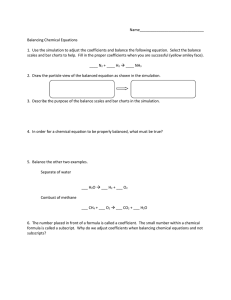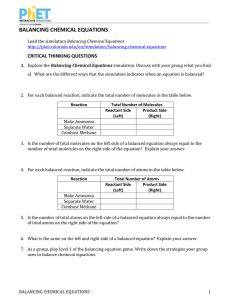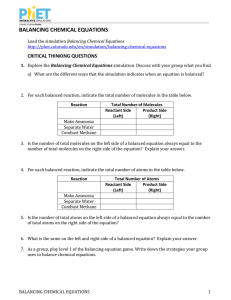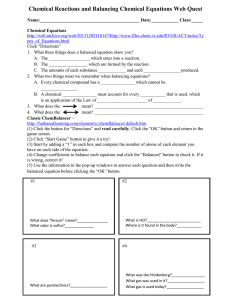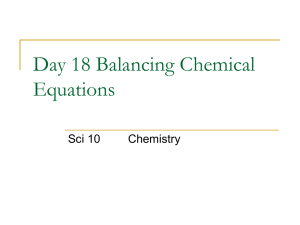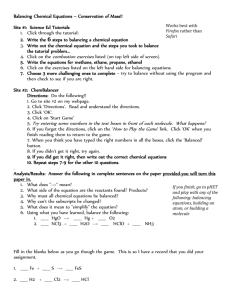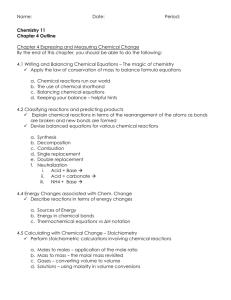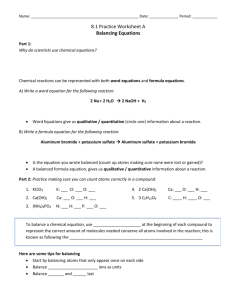Balancing Chemical Equations
advertisement
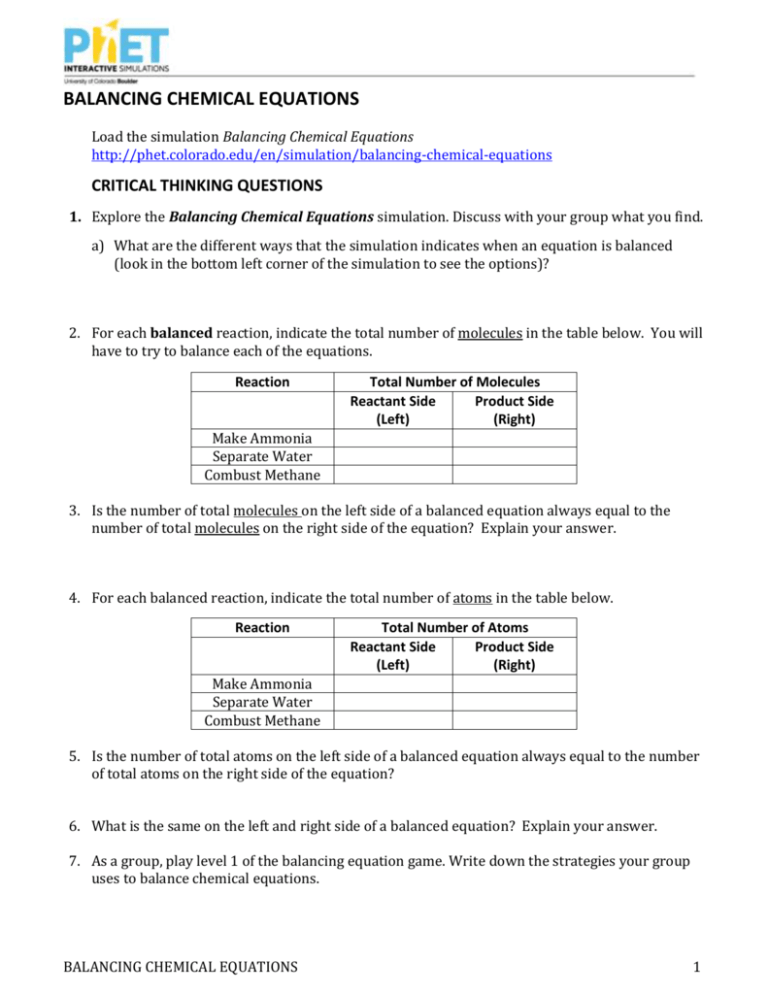
BALANCING CHEMICAL EQUATIONS Load the simulation Balancing Chemical Equations http://phet.colorado.edu/en/simulation/balancing-chemical-equations CRITICAL THINKING QUESTIONS 1. Explore the Balancing Chemical Equations simulation. Discuss with your group what you find. a) What are the different ways that the simulation indicates when an equation is balanced (look in the bottom left corner of the simulation to see the options)? 2. For each balanced reaction, indicate the total number of molecules in the table below. You will have to try to balance each of the equations. Reaction Total Number of Molecules Reactant Side Product Side (Left) (Right) Make Ammonia Separate Water Combust Methane 3. Is the number of total molecules on the left side of a balanced equation always equal to the number of total molecules on the right side of the equation? Explain your answer. 4. For each balanced reaction, indicate the total number of atoms in the table below. Reaction Total Number of Atoms Reactant Side Product Side (Left) (Right) Make Ammonia Separate Water Combust Methane 5. Is the number of total atoms on the left side of a balanced equation always equal to the number of total atoms on the right side of the equation? 6. What is the same on the left and right side of a balanced equation? Explain your answer. 7. As a group, play level 1 of the balancing equation game. Write down the strategies your group uses to balance chemical equations. BALANCING CHEMICAL EQUATIONS 1 8. Start level 2 of the balancing equation game. Take turns in your group to balance the equations in the sim, using your strategies from Level 1, and adding new strategies as needed. Each person should be in charge of balancing at least one equation, asking for help from the group as needed. As a group, write down the equations as you solve them. 9. In the simulation, were you able to use non-integer numbers (like ½ or 0.43) for the coefficients in a balanced equation? Why do you think this is? a) Which of the following are coefficients you could use in a balanced equation? ☐½ ☐¾ ☐1 ☐2 ☐6 ☐9 b) If you were balancing an equation containing the O2 molecule, which of the following would be correct representations of O2 and its coefficient? ☐ ½O2 ☐ O2 ☐ 3O2 ☐ 6O2 ☐ 3O ☐ 5O3 10. What do you have to do to the coefficients of equation I below to get to equation II? i. 2 SnO2 + 4 H2 2 Sn + 4 H2O ii. SnO2 + 2 H2 Sn + 2 H2O a) Both equation I and II are balanced, but equation I is the correct way to write the balanced equation. b) Can you divide equation II by another factor and still have it be correct? Why or why not? c) In a complete sentence, write down a method you could use to determine if an equation is written in the correct way. 11. Start level 3 of the balancing equation game. Take turns and write down the equations as you solve them, along with any new strategies you needed for balancing. BALANCING CHEMICAL EQUATIONS 2 CHALLENGE QUESTIONS: BALANCE THE EQUATIONS BELOW. A. ___ NaNO3 + ___ PbO ___ Pb(NO3)2 + ___ Na2O B. ___ Ca3P2 + ___ H2O ___Ca(OH)2 + ___ PH3 C. ___Fe2O3 + ___ CO ___Fe + ___ CO2 D. ___NH3 + ___ O2 ___ NO2 + ___ H2O E. ___ H2SO4 + ___ B(OH)3 __ B2(SO4)3 + ___ H2O F. ___FeS + ___O2 ___Fe2O3 + ___SO2 G. ___ C3H6O2 + ___ O2 ___ CO2 + ___ H2O BALANCING CHEMICAL EQUATIONS 3
